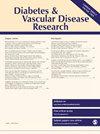Association between gamma glutamyl transpeptidase to HDL-Cholesterol (GGT/HDL-C) ratio and metabolic syndrome resolution after sleeve gastrectomy
IF 3
4区 医学
Q3 ENDOCRINOLOGY & METABOLISM
引用次数: 0
Abstract
ObjectiveTo evaluate the association between GGT/HDL-C ratio and resolution of MetS in adults after sleeve gastrectomy (SG).MethodsWe conducted a retrospective cohort study using secondary data from a Peruvian bariatric center. The study population consisted of adults aged 18 and above who underwent laparoscopic SG and were diagnosed with MetS prior to the surgery. The main outcome measured was MetS resolution 6 months post-surgery and the exposure variable was the GGT/HDL-C ratio.ResultsWe analyzed 137 patients with a mean age of 38.9 ± 10.9 years; 64.2% were females. The median GGT/HDL-C ratio was 1.1 [0.7 – 1.5], and 83.9% of patients experienced resolution of MetS. Furthermore, both the middle tertile of GGT/HDL-C (aRR: 1.28; 95% CI: 1.04 - 1.58; p = .019) and the lowest tertile (aRR: 1.27; 95% CI: 1.01 - 1.60; p = .038) showed a significant association with the resolution of MetS.ConclusionEight out of 10 patients undergoing SG experience resolution of MetS within 6 months after surgery. Patients in the middle and lower tertiles of the GGT/HDL-C were more likely to achieve this outcome. Therefore, the GGT/HDL-C ratio should be considered a valuable and efficient biomarker for preoperative assessment of bariatric surgery candidates.袖带胃切除术后γ谷氨酰转肽酶与高密度脂蛋白胆固醇(GGT/HDL-C)比率与代谢综合征缓解之间的关系
方法 我们利用秘鲁一家减肥中心的二手数据开展了一项回顾性队列研究。研究对象包括接受腹腔镜袖带胃切除术并在术前被诊断为 MetS 的 18 岁及以上成年人。测量的主要结果是术后 6 个月 MetS 的缓解情况,暴露变量是 GGT/HDL-C 比值。结果我们分析了 137 名患者,平均年龄为 38.9 ± 10.9 岁;64.2% 为女性。GGT/HDL-C比值的中位数为1.1 [0.7 - 1.5],83.9%的患者的MetS症状得到缓解。此外,GGT/HDL-C 的中间三分位数(aRR:1.28;95% CI:1.04 - 1.58;p = .019)和最低三分位数(aRR:1.27;95% CI:1.01 - 1.60;p = .038)与 MetS 的缓解有显著关系。GGT/HDL-C处于中间和低分位数的患者更有可能实现这一结果。因此,GGT/HDL-C 比值应被视为术前评估减肥手术候选者的一个有价值且有效的生物标志物。
本文章由计算机程序翻译,如有差异,请以英文原文为准。
求助全文
约1分钟内获得全文
求助全文
来源期刊

Diabetes & Vascular Disease Research
ENDOCRINOLOGY & METABOLISM-PERIPHERAL VASCULAR DISEASE
CiteScore
4.40
自引率
0.00%
发文量
33
审稿时长
>12 weeks
期刊介绍:
Diabetes & Vascular Disease Research is the first international peer-reviewed journal to unite diabetes and vascular disease in a single title. The journal publishes original papers, research letters and reviews. This journal is a member of the Committee on Publication Ethics (COPE)
 求助内容:
求助内容: 应助结果提醒方式:
应助结果提醒方式:


